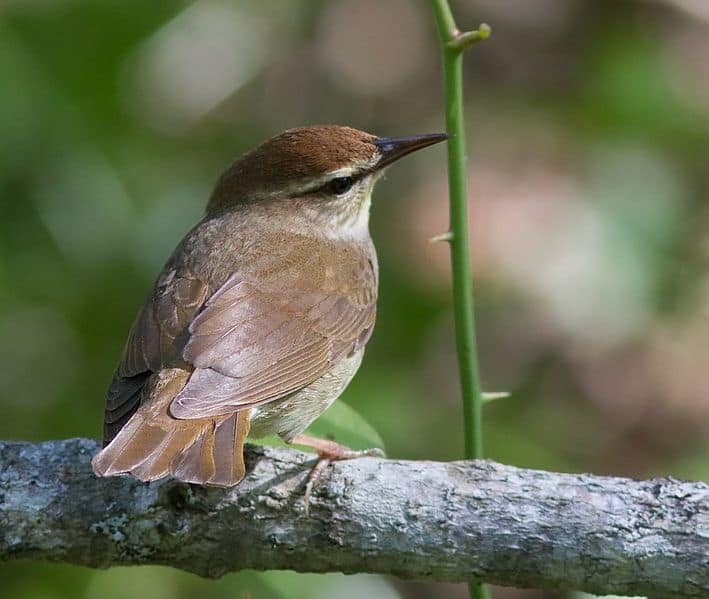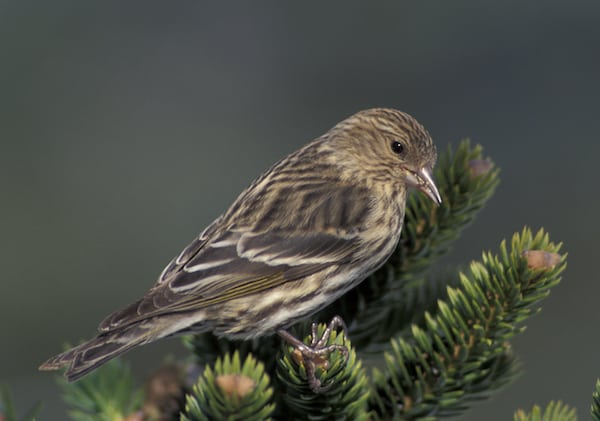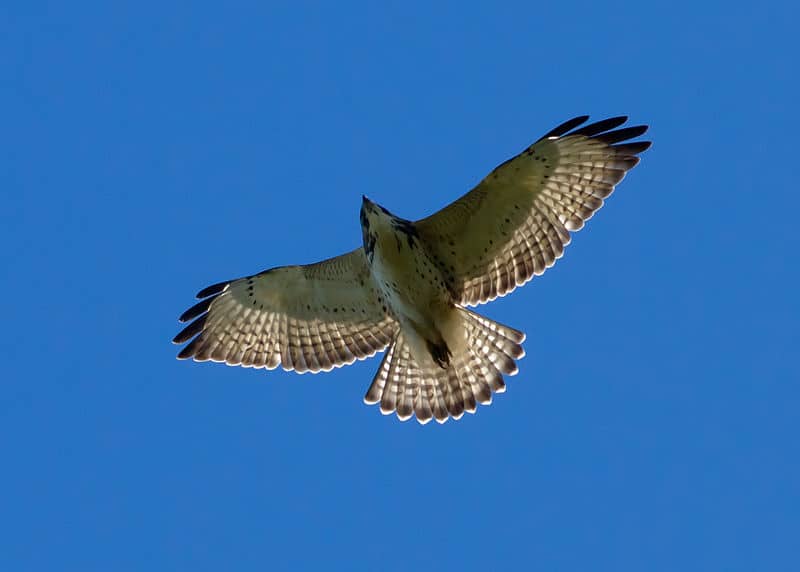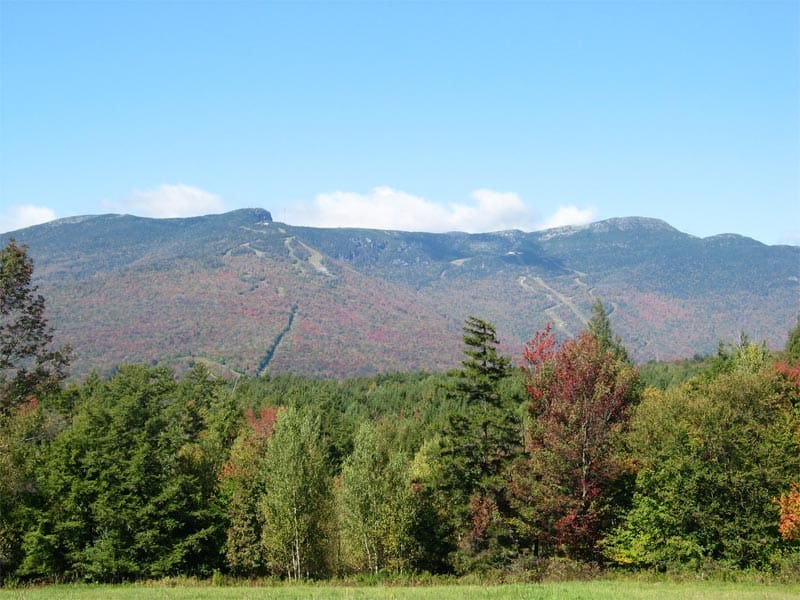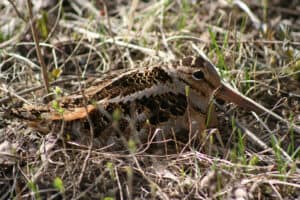
1. American woodcock
The American woodcock is a short-legged, short-tailed, dumpy-looking bird with no apparent neck and a long sharp bill. Its bulging dark eyes with dark eyeline are set high on the head adding to its odd look. Both males and females are orangish underneath with camouflage patterned gray- and reddish-brown back and wings and broad bars on the crown. The woodcock is a shorebird whose short wings let it live easily in the wet woods, swamps, and shrubby fields it prefers. It is known and sought out for its courtship displays.
One of the best ways to see the bird, anywhere in the state, is to join a “woodcock walk” to one of its singing grounds sponsored by local parks or bird clubs. The best time is from late January through March, as long as it is above freezing, and at dawn, dusk, or on a moonlit night. From about 15 minutes after sunset, for about a half hour, the male woodcock will explode skyward, its wings twittering in song, and then settle back into the grassy field, usually with open areas, from which it flew. During the show, he will repeatedly give his peent call to keep the attention of the female below.
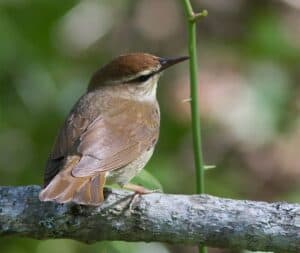
2. Swainson’s warbler
The Swainson’s warbler is a neotropical migrant that breeds regularly in the state but is uncommon, very secretive, and elusive. A birder, even looking for it intentionally, may not see the first one for years. It is a small, plain brown bird, slightly lighter below, but with a strong whitish eyebrow stripe and dark eye-line. It has a long, pointed, straight bill it uses to search for insects in the leaves on the ground. Its legs are pink. The sexes are alike. It is best found by its loud, slurry, five-note song on the nesting grounds. Learn to distinguish it from the similar Louisiana waterthrush’s song to know you are on the right bird; the waterthrush seems to splutter more at the end.
The Swainson’s warbler is found in three distinct breeding areas of the state. In West Tennessee it is found in swamps, thickets, and bottomland canebrakes. In the east, on the plateau and Cumberland Mountains and in the higher mountains, it is found in ravines, near water in thickets of great laurel, often near hemlocks, and in other dense undergrowth. A good place to look for it, beginning in late April, is the lovely, mountain valley, Cove Lake State Park at Careyville, on the eastern edge of the Cumberland Mountains. The bird has been reliably found here for several years and the site is quite accessible. But remember, with the Swainson’s, there’s no guarantee.[Park office: (423) 566-9701]
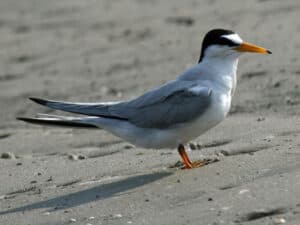
3. Least tern
The interior least tern (S. a. athalassos) is a locally common summer resident that nests on sand and gravel bars in the Mississippi River along the state’s western border. It has been on the U.S. Fish and Wildlife Service Endangered Species list since 1985, but the Tennessee area population is reportedly relatively secure, assuming no increase in the recreational use of its nesting grounds.
The least tern is the smallest American tern, 8 to 9 inches long, with a wingspan of 20 inches. The breeding adult is gray above with a white underside, a black cap and nape with a white forehead. The sharp-pointed bill is orange-yellow in the early season with a black tip; later it is greenish. The legs are bright orange or yellow. The flight is rapid, sometimes bouncy, often punctuated with squeaks or squeals. The bird feeds mainly on small fish caught in shallows often knifing straight down into the water with wings folded.
Look for the least tern beginning in mid-May along the river from Memphis to Tiptonville. In most years they nest at 20 or more locations on this stretch of The Big Muddy. Check the internet for where they are being seen. Fall migration, from July through early September, provides looks at these terns and others from locations up river. Some migrants are seen in other parts of the state.

4. Blue grosbeak
The blue grosbeak goes through several plumage changes as it matures, and though it is larger, it is sometimes confused with the indigo bunting, a bird that goes through similar changes. Adult male blue grosbeaks are deep blue with two rusty red wing bars. Adult females are pale gray-brown with buff brown wing bars and noticeable blue on the rump. The bills of both are large and sliver-gray.
The song is an unbroken series of rich, mumbled warbles, similar to the house finch and may be confused with the song of the orchard oriole. Get to know the song since blue grosbeaks often practice being hard to see. Until the 1940’s none were recorded in the state. Now they are widespread, common, and breeding.
A good place to look for the blue grosbeak is Land Between the Lakes, a Tennessee Valley Authority-managed recreation area that lies at the northwestern corner of Middle Tennessee and stretches some forty miles into Kentucky. From U.S. 79 east of Paris Landing the Trace through this 300-square-mile natural area lying between the impounded Tennessee and Cumberland Rivers (Kentucky Lake and Lake Barkley) passes many areas of good habitat for the bird. Go in mid-May to late-June and listen and look for them early and late in the day in brushy clearings, fencerows and blackberry thickets where they prefer to nest.

5. Black-throated blue warbler
A neotropical migrant that nests in the Northeast and eastern Canada but also at the higher altitudes of the Appalachains including the high mountains of East Tennessee. The male is striking in dark blue black above, black on the face and sides, and snow-white underneath, with a white “handkerchief” wing-patch.
The adult female is olive-drab above, buffy underneath, with a light eyebrow line and dark cheek. There may be a small white wing-spot in the same location as that of the male. The bird is usually seen foraging low in the understory of deciduous trees. The song is a lazy, wheezy series of zhwee notes with the last note rising.
These beautiful wood-warblers begin nesting shortly after they arrive in the mountains in April but may extend breeding through the summer into August. They can be found above 3,000 feet elevation all along the North Carolina border. A good time to search is in July or August, when it is steamy down below but is refreshingly cool in the high mountains. The birds can be found at many spots in the Smokies and at Roan Mountain farther north. Along with the dark-eyed junco, it is thought to be the most abundant bird in these mountains, so a search should be rewarding. Look for the birds foraging low in the canopy and brushy understory, not in the treetops.
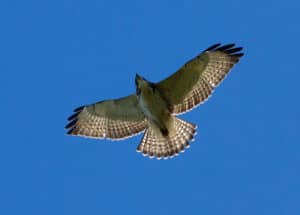
6. Broad-winged hawk
This small, stocky hawk is not as large as the average crow. It is quite common in the summer in the woods of the state. The adult male and female are both brown on the back with reddish barring on the chest. The immature is more streaked on the sides and chest. In flight the tail is banded black and white, with the terminal band the broadest.
The wings are white underneath, trimmed in black, and the wingtips are black. As with most hawks, there are many different looks depending on the maturity and the morph. Within their territory they are often quite tame, and when found feeding along a wooded county lane, along some other roadside, or in the deep woods they can be approached closely and may tolerate your presence for a long period.
If you have not yet seen the broad-winged somewhere in the woods or along the country lanes by summer’s end, look for it in mid- to late-September at the peak of its southern migration through the state. It can be best seen from a ridge or a fire tower toward the eastern part of the state. Try the Soddy Mountain Hawk Watch north of Chattanooga or Sharp’s Ridge in Knoxville.

7. Common loon
The common loon is a large, long-bodied, fish-eating diver. Among the loons the common is second only to the yellow-billed in size. On the water it appears to be and is much larger than most ducks it may be seen with. In winter plumage the back of the head and neck is dark but there is a whitish indentation mid-neck. The back is lighter than the neck and head and the undersides are whitish. The bill is stout, straight and gray with a slightly darker tip in winter juveniles and adults. The haunting, yodeling calls are not often heard in winter.
Migration of the common loon through the state is November and March, and many winter here. Sometimes hundreds, even thousands, form in rafts on the larger bodies of water. A great place to see this bird and other loons is Pace Point at Big Sandy from November on. Just recently, for the first time ever reported anywhere in the state, all four loons – common, pacific, red-throated, and the very rare, yellow-billed – we seen at this site in one scope view! Single common loons, or small groups, may be found on smaller lakes or large ponds, some even in heavily populated areas. It is sometimes possible to observe the same bird in such a location for weeks or even months through the cold season. Some birds do stay in the state over the summer.
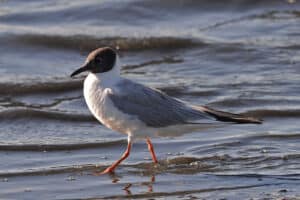
8. Bonaparte’s gull
One of our three regular winter gulls, along with the ring-billed and the herring gull, this small bird has been called “dainty,” “petite,” and “ternlike,” all of which are apt. The winter adult is gray above and white below with black wingtips and lacks the black hood of the summer bird. There is a dark smudgy ear spot, the bill is slender and black, and the legs are orange-red. This is a two-year gull, and the first-winter bird has pinkish legs and dark brown on the leading edge of the wing. The “Bonie”, as it is called, is seen less frequently than the others but when seen may be in large flocks.
A good time to see the Bonaparte’s gull is in December or January as they gather on our human-made lakes throughout the state. A good place to see them is at Pickwick Landing Dam and State Park, near Savannah, in Hardin County, and nearby areas along the river frequented by gulls. A number of rare or uncommon gulls have been seen in this area, including the state’s only ivory gull seen here in February, 1996. [Park office: (731) 689-3129]
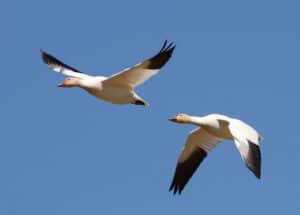
9. Snow goose
The snow goose is smaller than most Canadas and most other species of goose found in Tennessee except for the much-less-common Ross’s, with which it is sometimes seen. In its white morph it is white with black primary feathers. Its bill is pink and always has a black grin patch on the side (the Ross’s lacks this). Its feet are pink. Its voice is different from the honk of the Canada, more of whouk which is often given in unison by a flock.
Until recent years the bird was not commonly seen in the state and the darker morph, once considered a separate species and called the “blue goose”, was reportedly the plumage type seen most often. Today large winter flocks are regular in both the western and the eastern parts of the state, and the white juveniles and adults seem to predominate.
The month of January is good for seeing snow goose and there are no better spots than Reelfoot and Hiwassee. Sometimes thousands of snow geese can be seen in one flock. Snow geese, unlike, say, Canada geese, feed by uprooting grass and grain shoots, and this can cause significant damage to commercial operations and be costly in managed feeding areas. For this reason there may be more liberal hunting regulations on this species at times and in various areas, and there may generally be more “hard feelings” on the part of nonbirders toward this beautiful bird.

10. Sandhill crane
The sandhil crane is one of the tallest, if not the largest, birds to be seen in Tennessee. Along with the great blue heron, which is much more common, it may stand over 4 feet tall and its wingspread can be 7 feet. Only the bald eagle’s wingspan surpasses it. The sandhills that migrate through Tennessee in fall are from nesting areas around the Great Lakes and are moving to wintering grounds in Florida. They return north by the same route in the spring. The bird is long-necked, with long blackish legs and feet, and is all-gray with a bald red forehead.
During their stopovers in the state, the cranes roost together at night standing in flocks, often in shallow water, and then at dawn fly to nearby fields or marshes to feed. Their rattling, bugle-like garooo-a-a-a calls can be deafening in unison. They are high-altitude migrants and their calls can often be heard from far overhead even before they can be seen descending rapidly in small squadrons to join a flock that has already gathered on the ground and that is calling up to them. It is an amazing spectacle when the entire resting flock lifts off all at once in response to a raptor or some other alarm.
For over a decade, one of the best ways to see sandhill cranes is to attend the annual festival the Cherokee Heritage and Sandhill Crane Viewing Days in early February at the Hiwassee Wildlife Refuge in Meigs County north of Chattanooga. Over 5,000 cranes are often present. Call (423) 334-5850 for information.

